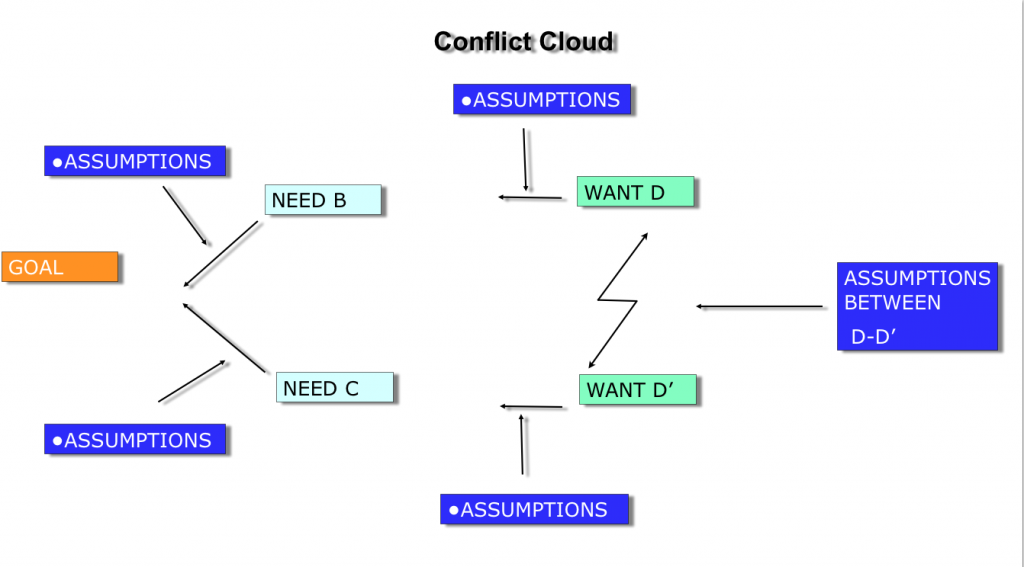 Dr. Domenico Lepore, international expert in systemic management, offers unique insight into the Conflict Cloud tool, a systemic Thinking Process Tool from the Theory of Constraints. Dr. Lepore developed the Decalogue Management Methodology together with Oded Cohen.
Dr. Domenico Lepore, international expert in systemic management, offers unique insight into the Conflict Cloud tool, a systemic Thinking Process Tool from the Theory of Constraints. Dr. Lepore developed the Decalogue Management Methodology together with Oded Cohen.
Virtually any situation of blockage can be portrayed in terms of conflict. There are at least three main advantages in doing so:
first, we see with true clarity the issue at stake, we understand “why” we are in conflict; second, we deflate the potentially growing bubble of resentment associated with a conflict and keep at bay ill feelings as much as possible. The third and most important advantage is that by building a conflict with precision we are automatically poised to solve it; I will try to explain why.
 With the Thinking Process Tool called the Conflict Cloud,we analyze a conflicting situation in terms of its three founding statements:
With the Thinking Process Tool called the Conflict Cloud,we analyze a conflicting situation in terms of its three founding statements:
- the “wants”, i.e. our claims;
- the “needs”, i.e. what we try to satisfy/protect with our claims;
- the “common goal”, something that can only be achieved if both needs are satisfied/protected.
The goal then, really becomes “common” to both conflicting parties.
Challenging our mental models and seeing others
What paves the way to the resolution of the conflict is a fourth set of statements, the
assumptions. What connects the boxes and provides conceptual solidity to the conflict is the set of mental models, the beliefs we call “assumptions”; these portray the logic by which we see the conflict as inevitable. Once these mental models are in the open it becomes possible to challenge them and replace them with less “constraining” ones; in other words, by surfacing our limiting beliefs we provide ourselves with the practical possibility to verify the validity of such beliefs and find a way out of them.
The way we do this is through the development of “injections”, solutions that while
invalidating the assumptions that led to the conflict, protect both needs in the conflict.
I think it is important to stress the inherent difficulty of this exercise. By verbalizing the profound images that shape the way we think, by exposing the way we look at the world, by making explicit how we interpret reality we simultaneously show a very intimate part of ourselves and we accept to challenge it too. Moreover, by accepting to modify these mental images, implicitly we accept to change our outlook on the world and, in some cases, change ourselves. Changing mental models that have been created over time is very complicated and requires a serious commitment towards a sincere betterment of the most relevant part of our being, the way we think.
Beyond the Conflict Cloud: Connection and Transformation
This is because, and I will never stress this enough, the seemingly simple conflict
diagram is far from being a “tool”, like a hammer or a piece of software. Embracing the
conflict cloud approach to problem solving calls for the acceptance of a new paradigm of openness and transparency about ourselves; it requires the systematic and relentless
acceptance of others’ views; it is based on the deep conviction that sundering ourselves from others is artificial and never truly possible. The conflict cloud, through its paradoxical nomenclature, is the key to creating connection, to linking positions, and to building bridges.
In pursuing the overcoming of conflicts through the identification of their ultimate root
(our assumptions) we create the mental circuitry that enables us to develop seemingly
inconceivable solutions; we open up a realm of new possibilities, we transcend ourselves and create a much broader range of possibilities for interactions.
This is why the conflict cloud is not simply a “tool” to address disputes; rather it is the
starting point for transforming how organizations can be built and work in a much more meaningful way. The conflict cloud supports and fortifies intuition.
See also:
Our Training Sessions to learn these Tools.
Our book: Sechel: Logic, Language and Tools to Manage any Organization as a Network
Separating Wants from Needs: Tools for Thinking Systemically
Change: Tools for Thinking, Planning and Enacting Change





This is interesting; but not clear whether you work with this model step by step, or follow any systematic process. Could you explain?
Hi Meinhard. We’ll be looking at the tools further in the following posts. You will also find a lot more information in the books by Lepore ‘Deming and Goldratt: the Decalogue’ and ‘Sechel: Logic, Language and Tools to Manage any Organization as a Network.’